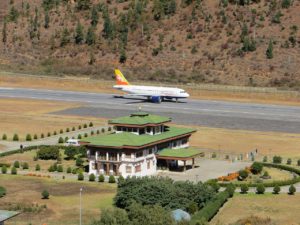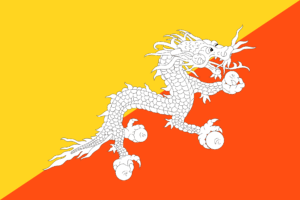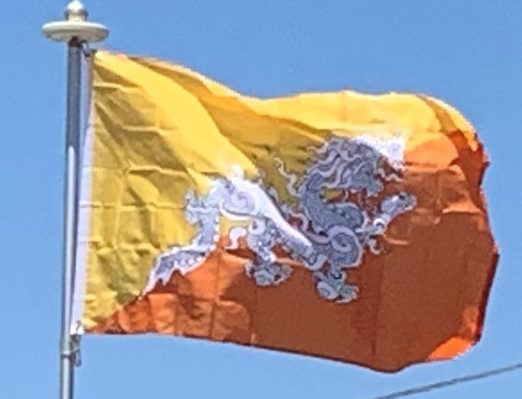
Road:
The Lateral Road is Bhutan’s primary east–west corridor, connecting Phuentsholing in the southwest to Trashigang in the east. In between, the Lateral Road runs directly through Wangdue Phodrang, Trongsa and other population centres. The Lateral Road also has spurs connecting to the capital Thimphu and other major population centres such as Paro and Punakha. As with other roads in Bhutan, the Lateral Road presents serious safety concerns due to pavement conditions, sheer drops, hairpin turns, weather and landslides.
Since 2014, road widening has been a priority across Bhutan, in particular for the North-East-West highway from Trashigang to Dochula. The widening project is expected to be completed by the end of 2017 and will make road travel across the country substantially faster and more efficient. In addition, it is projected that the improved road conditions will encourage more tourism in the more inaccessible eastern region of Bhutan. Currently, the road conditions appear to be deterring tourists from visiting Bhutan due to the increased instances of road blocks, landslides and dust disruption caused by the widening project.
Rail:
Bhutan has no railways, though it has entered into an agreement with India to link southern Bhutan to India’s vast network by constructing an 11 mile-long broad gauge rail link between Hashimara in West Bengal and Toribari in Bhutan. The construction of the railway via Satali, Bharna Bari and Dalsingpara by Indian railways will be funded by India. Bhutan’s nearest railway station is Hasimara.
Flag of Bhutan:
The national flag of Bhutan is one of the national symbols of Bhutan. The flag is based upon the tradition of the Drukpa Lineage of Tibetan Buddhism and features Druk, the Thunder Dragon of Bhutanese mythology. The basic design of the flag by Mayum Choying Wangmo Dorji dates to 1947. A version was displayed in 1949 at the signing of the Indo-Bhutan Treaty. A second version was introduced in 1956 for the visit of Druk Gyalpo Jigme Dorji Wangchuk to eastern Bhutan; it was based upon photos of its 1949 predecessor and featured a white Druk in place of the green original.

The Bhutanese subsequently redesigned their flag to match the measurements of the flag of India, which they believed fluttered better than their own. Other modifications such as changing the red background color to orange led to the current design, in use since 1969.
Origins:
Historically Bhutan is known by numerous names, but the Bhutanese call the country Druk after the name of the Bhutanese thunder dragon. This tradition dates to 1189 when Tsangpa Gyare Yeshe Dorje, founder of the Drukpa lineage of Tibetan Buddhism, was in Phoankar (Tibet) where he reportedly witnessed the Namgyiphu valley glowing with rainbow and light. Considering this an auspicious sign, he entered the valley to choose a site for the construction of a monastery, whereupon he heard three peals of thunder – a sound produced by the druk (dragon) according to popular Bhutanese belief. The monastery that Tsangpa Gyare built that year was named Druk Sewa Jangchubling, and his school of teaching became known as Druk. The Druk school later split into three lineages. One of these three, Drukpa, was founded by Tsangpa Gyare’s nephew and spiritual heir Önrey Dharma Sengye and afterward spread throughout Bhutan. The nation itself would also later become known as Druk. This legend offers one explanation for how the symbolism of the dragon came to form the basis of the national flag of Bhutan. An alternative hypothesis maintains that the notion of symbolizing sovereign and state in the form of a dragon emerged in neighboring China and was adopted by the rulers of Bhutan as a symbol of royalty in the early 20th century.
Current Flag:
The current flag is divided diagonally from the lower hoist-side corner, with the upper triangle yellow and the lower triangle orange. Centered along the dividing line is a large black and white dragon facing away from the hoist side. The dragon is holding a norbu, or jewel, in each of its claws.
Symbolism:
According to The Legal Provisions of the National Flag of the Kingdom of Palden Drukpa as Endorsed in Resolution 28 of the 36th Session of the National Assembly held on June 8, 1972, and as restated in the Constitution of 2008, the yellow signifies civil tradition and temporal authority as embodied in the Druk Gyalpo, the Dragon King of Bhutan, whose royal garb traditionally includes a yellow kabney (scarf). The orange half signifies Buddhist spiritual tradition, particularly the Drukpa Kagyu and Nyingma schools. Druk, the Thunder Dragon, spreads equally over the line between the colors. The placement of Druk in the center of the flag over the dividing line between the flag’s two colors signifies the equal importance of both civic and monastic traditions in the Kingdom of Druk (Bhutan) and evokes the strength of the sacred bond between sovereign and people. The white color of Druk signifies the purity of inner thoughts and deeds that unite all the ethnically and linguistically diverse peoples of Bhutan. The jewels held in Druk’s claws represent Bhutan’s wealth and the security and protection of its people, while the dragon’s snarling mouth symbolizes Bhutanese deities’ commitment to the defense of Bhutan.
